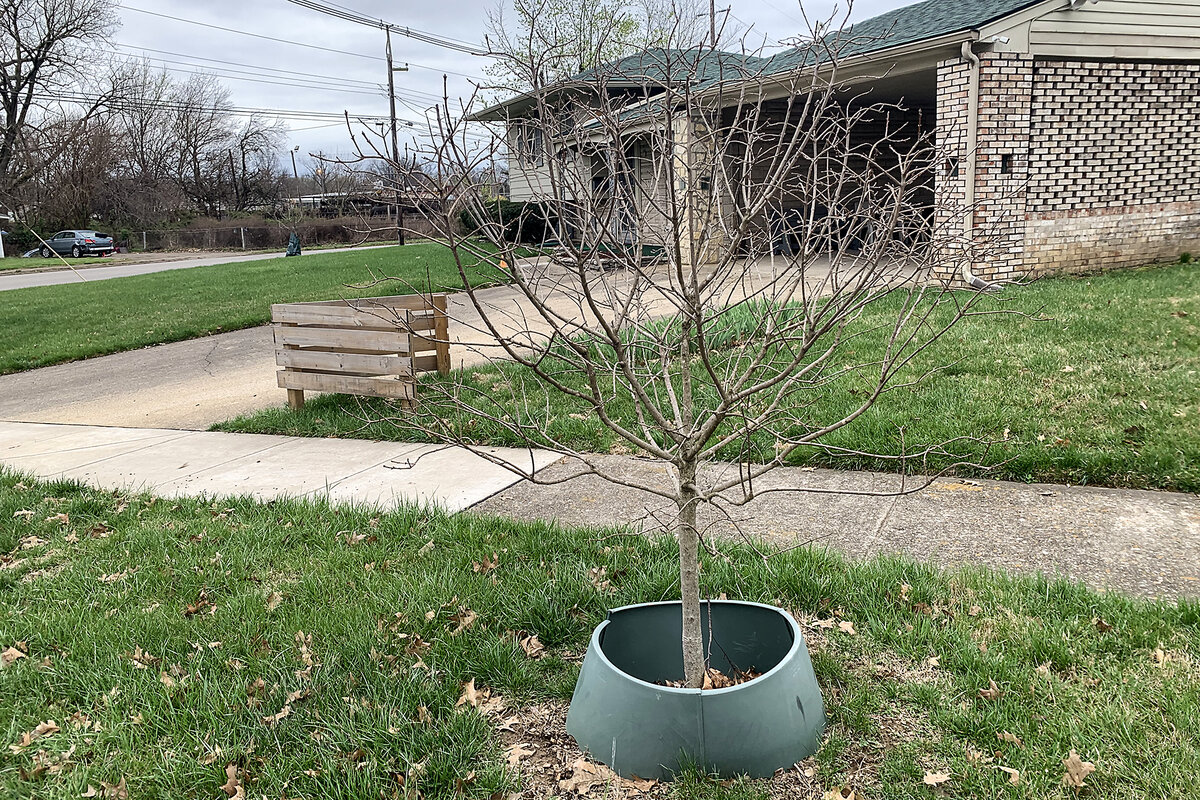Low-income areas lack trees, yet they often turn them down. Here’s why.
Loading...
| LOUISVILLE, KY.
Many low-income urban areas in the United States have a pressing need for trees. With about half as much tree canopy coverage as their affluent counterparts have, these areas face a host of risks, such as air pollution and dangerously high heat.
But government tree-planting programs meant to close this gap can face resistance from the very communities they intend to help. The resistance, research shows, is tied not only to residents’ lack of means to maintain trees but also to distrust.
Why We Wrote This
A story focused onTrees help with cleaner air and cooler temperatures, yet some residents in low-income areas distrust efforts to plant more. That’s changing as groups gather buy-in from locals.
As ambitious tree-planting projects take place across the country, cities and nonprofits are exploring how to better integrate the needs of underserved communities in their work.
Having a choice about which trees to plant near her house was important to LaDonna Faye Barnett in Louisville, Kentucky. Previous trees planted by the city caused decades of problems. TreesLouisville, a nonprofit started by local civic leaders, allowed her to chose black gum trees, which are smaller.
“In a lot of lower-income communities, there’s been a lack of investment in tree care by the city,” says Christine Carmichael, a forestry consultant. “And so there’s a real need now to have some accountability and rebuild trust.”
Many low-income urban areas in the United States have a pressing need for trees. With about half as much tree canopy coverage as their affluent counterparts have, these areas face a host of risks, such as air pollution, poor water quality, and dangerously high heat.
But government tree-planting programs meant to close this gap can face resistance from the very communities they intend to help. The resistance, research shows, is tied not only to residents’ lack of means to maintain trees but also to distrust.
“In a lot of lower-income communities, there’s been a lack of investment in tree care by the city,” says Christine Carmichael, a forestry consultant who wrote a book on the impact of racism on urban trees. “And so there’s a real need now to have some accountability and rebuild trust.”
Why We Wrote This
A story focused onTrees help with cleaner air and cooler temperatures, yet some residents in low-income areas distrust efforts to plant more. That’s changing as groups gather buy-in from locals.
As ambitious tree-planting projects take place across the country, cities and nonprofits are exploring how to better integrate the needs of underserved communities in their work.
LaDonna Faye Barnett wanted trees on her Louisville, Kentucky, property. She liked having shade, but did not want trees that would grow too large.
It had taken her two decades to get the city to remove two pin oaks from the easement in front of her home. The city trees’ heavy branches hung over her yard and carport, and their roots had pushed up the sidewalk, causing people to trip. Getting rid of the trees herself required permission from the city and would have cost thousands of dollars, which she could not afford, Ms. Barnett says.
The city eventually cut down the trees in 2020. “It took me 20 years of continuously complaining,” Ms. Barnett says.
But after that, she had a good experience with TreesLouisville, a nonprofit that planted three trees in her yard and in the easement for free.
The group, founded by local civic leaders in 2015 in response to Louisville’s declining tree canopy, focuses its planting efforts on historically redlined neighborhoods and other areas with low canopy. The group makes sure to get resident buy-in before planting on or in front of their property, and lets residents choose from a list of available tree species, says Cindi Sullivan, its executive director.
Having that choice was important, says Ms. Barnett, who picked black gum trees for her yard, partly because they will not grow too large. The staff of TreesLouisville planted the trees and gave her instructions on how to care for them. She has not had any issues with them since, and says she enjoys the beauty of their leaves.
“It was a perfect time for somebody that knew what they were doing to guide you,” Ms. Barnett says.
Residents “had been left out”
Urban forestry programs have not always taken low-income communities’ needs into account.
Between 2011 and 2014, the city of Detroit worked with a nonprofit to plant free street trees, primarily in low-canopy areas. But a quarter of the 7,425 residents reached by the initiative turned down the offer, despite being informed of the many potential benefits of trees. Their refusal, says Dr. Carmichael, who co-wrote a study on the Detroit case, stemmed partly from a history of negative experiences with the city.
“People had been left out of a lot of decisions around urban trees and where to plant them, what types of trees to plant, and why,” she says. “If [residents] were going to accept a new tree, they wanted to be able to select from a menu of trees, rather than having someone select the tree for them, which was the way the program was run when I was doing the research.”
In her consulting work with forestry projects across the country, Dr. Carmichael has seen similar issues play out. People may want trees on or near their properties for shade or beauty, or as a source of food in a food desert. Yet sometimes cities and nonprofits want to plant trees that will grow larger and provide more ecosystem benefits.
“When you have communities that have been through a lot of challenges with larger trees that haven’t been cared for, it’s a pretty tough sell,” she says. She recommends cities and nonprofits work on building strong communication with residents and collaborate with them to maintain new trees in the long term.
Captains from the community
During a planting season in early 2024, James Huerta found homes for 43 trees in his neighborhood in Nashville, Tennessee.
He has been volunteering since 2021 as a “neighborhood planting captain” for Root Nashville, a public-private partnership that plants free trees in low-canopy areas. The planting captains share information in their communities about Root Nashville’s tree offerings, and refer residents to staff who can guide them in the planting and tree care process.
Residents can choose from among five tree species for each planting season, says Mekayle Houghton, executive director of Cumberland River Compact, a nonprofit that leads Root Nashville’s daily operations.
Since its founding in 2018, Root Nashville has worked with 109 planting captains, who have facilitated the planting of more than 10,000 trees, the group says. Root Nashville also pays a stipend to the planting captains when funding is available. There have been 20 beneficiaries so far, whose stipends ranged from $150 to $1,000, the group says.
Mr. Huerta says two factors help him build trust with residents: the fact that he has three trees from Root Nashville in his own yard, and the fact that he is part of the community he works with.
“I can be like, ‘That house on Antioch, that’s where we live.’ It helps a lot,” he says.
Ambitious goals
In the effort to reverse tree loss, the need for efficiency can come at the expense of trust-building.
America’s urban tree cover is projected to decrease by 8.3% between 2010 and 2060, due to factors such as pests and diseases, development, and extreme weather events. Reversing this trend would require the planting of 31.4 million trees every year – an annual investment of $8.9 billion, according to a study by American Forests, a conservation nonprofit.
In 2023, the U.S. Forest Service announced it will invest $1.1 billion in 385 projects aimed at creating equitable access to trees and green spaces.
Root Nashville’s goal – planting 500,000 trees by 2050 – is very ambitious, says Ms. Houghton, all the more because the group requires residents’ buy-in before planting in easements, which belong to the city.
“It’s very time-consuming communicating with residents,” she says. “The more efficient you get, the more of the human touch you lose. And the human touch is sort of what builds trust.”
“This is really a grassroots campaign to get people to say they want trees,” she says. “It’s a big investment in education and time.”










